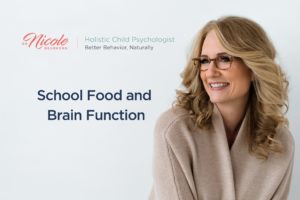ADHD is the most commonly diagnosed neurodevelopmental disorder in the United States, with the CDC estimating that 11% of American children have the disorder.
Research has indicated that several specific nutrients may play a role in ADHD symptoms.1 Various laboratory tests can measure nutrient levels to determine if they are clearly deficient, or lower than what would be considered optimal levels. These assessments can then help with appropriate nutrition-focused treatment planning to reduce symptoms.
In today’s post, I will go through each of the 4 nutrients and explain why each is critical for your child’s development and function.
Vitamin D is critical for EVERY brain function and body system
Vitamin D is a hormone found in every tissue of the body, making it critical for the appropriate function of every brain and body system. It is needed for bone health, immune system support, brain development, and neurotransmitter function. Reduced levels of vitamin D have become more common in the general population, and have been connected to many mental health symptoms.2 Children who eat a nutrient-poor diet, do not get adequate sun exposure, have darker skin pigmentation, or take certain prescription medications are at higher risk of vitamin D deficiency. Multiple studies have shown that children with ADHD symptoms have lower vitamin D levels compared to children without these symptoms, making it an appropriate nutrient to assess and target in treatment.3,4
The best way to assess vitamin D levels is a blood test to measure the level of 25-hydroxy-vitamin D in the body, which is typically written as 25(OH)D. While there are other blood measurements of vitamin D, this is the best way to obtain the current level of circulating vitamin D in the system. This blood test can be done via a blood draw at a laboratory, or with a finger prick test kit at home. A level below 20ng/mL is considered deficient, although many practitioners now agree that anything below 30ng/mL indicates deficiency. The Vitamin D Council has determined that 50ng/mL is the optimal level of vitamin D for most people. Children exhibiting ADHD symptoms and with a vitamin D level below the optimal range may benefit from increasing vitamin D consumption via supplementation and direct sun exposure, as food is typically an insufficient avenue for increasing vitamin D levels.
Zinc is critical for immune function, neurotransmitter production, and cognitive function
Zinc is a mineral known to play a role in immune function, wound healing, bone health, neurotransmitter production, cognitive function; and is required for over 300 enzyme processes in the body. It is also involved in melatonin production and regulation, dopamine transport, and is needed to turn vitamin B6 into its active form so that tryptophan and serotonin (neurotransmitters that help regulate mood) can be produced. Zinc also supports the body’s ability to use essential fatty acids like Omega 3’s, and is necessary for proper sensory functioning in areas such as taste and smell. Children with low zinc levels are likely to have impaired growth, and those who eat a vegetarian or vegan diet are at greater risk of zinc deficiency. Research has identified that neurotransmitters, essential fatty acids, melatonin, and sensory issues are connected to ADHD symptoms.5 Therefore, it makes sense to evaluate zinc levels to determine if they may be contributing to your child’s issues.
Measuring zinc can be done by laboratory analysis of hair, blood plasma, blood serum, and urine. It is a tricky issue because blood plasma and serum levels indicate only short-term zinc status, while hair analysis can provide a better measure of longer-term zinc levels. There is also an informal oral liquid zinc test that is done by some nutrition professionals as a basic indicator of zinc status. Starting with a blood plasma or serum measurement is often the easiest path, as most primary care physicians are familiar with these tests. The reference (normal) range for serum zinc is .66 to 1.10 mcg/mL, and if results show lower levels then this is most certainly an issue to address. If results come back showing plasma or serum zinc levels in the reference range it does not mean that zinc levels are optimal. Increasing zinc consumption through zinc-rich foods and/or supplements may result in symptom reduction. Multiple studies have demonstrated ADHD symptom improvement with zinc supplementation, while others have not shown significant benefit.6
Magnesium is critical for those calming and happy neurotransmitters we know as dopamine and serotonin
Magnesium is a mineral that plays a role in over 300 processes in the body. It is necessary for the production of fatty acids and is involved in muscle relaxation and energy production. Magnesium is also involved in neurotransmitter function, including dopamine and serotonin. This mineral has long been associated with calming and relaxation and can be helpful for many issues including anxiety, insomnia, and hyperactivity. It is estimated that a high percentage of children and adults in the United States have suboptimal levels of magnesium due to diets deficient in whole grains, nuts, and dark leafy greens. Many processed foods and medications also deplete magnesium levels. Studies have shown that children with ADHD symptoms, specifically impulsivity and hyperactivity, may have lower levels of magnesium than children without these symptoms.7
Testing for magnesium levels can be done with a blood test measuring plasma/serum or red blood cell (RBC) levels. Hair and urine tests are also available. While plasma/serum levels are often used, this can be problematic because this measure does not indicate the amount of usable magnesium within cells. The body tightly regulates magnesium levels, meaning that it will take stores of magnesium from the bones to keep blood levels adequate. Therefore, it is possible for someone to have a deficiency in magnesium without it showing up on a standard plasma/serum test. RBC testing may be a more appropriate measurement of true levels of magnesium in the cells, although more research is needed in this area. Requesting blood work to identify magnesium levels is an appropriate starting point, and most practitioners will order a plasma/serum level unless RBC is specifically requested. The reference range for RBC magnesium is generally around 4.2-6.8mg/dL, with some experts believing that optimal levels are closer to 6.0-6.5mg/dL. While we do not yet have definitive placebo-controlled double-blind studies demonstrating the benefits of magnesium for ADHD symptoms, preliminary evidence shows that there may be some benefit for reducing hyperactivity and impulsivity symptoms.8 There is also evidence to suggest that issues commonly associated with ADHD such as irritable mood, aggressive behavior, sleep problems, and anxiety may benefit from increasing magnesium levels.9
Iron is critical for supporting physical and cognitive growth
Iron is a mineral that is critical for supporting physical and cognitive growth in children. It is also connected to dopamine activity in the brain. Research has shown that iron deficiency in children is associated with many significant problems including cognitive impairment, reduced attention span, sensory issues, and emotional and behavioral regulation problems.10 Reduced iron levels are also connected to Restless Leg Syndrome (RLS), which is an issue for a significant number of children with ADHD symptoms.11 Studies have shown that children with ADHD have significantly lower levels of ferritin (iron) than children without the diagnosis.12 Children with limited diets due to picky eating, feeding problems, or reduced food intake may be at higher risk of iron deficiency. Those who eat a vegetarian or vegan diet without sufficient sources of iron are also at higher risk of deficiency, as well as children with certain immune or other medical conditions. Teen girls are also at higher risk of reduced iron levels due to menstruation.
There are various ways to test for iron levels, but serum ferritin is the best option in relation to ADHD symptoms.13 Serum ferritin measures the amount of iron in the cells, whereas serum iron measures the amount of iron only in the blood. It is a more sensitive and useful measure, and it is important to specifically request that your child’s healthcare provider order the serum ferritin test. This test is typically done via a blood draw but can be conducted with a finger prick test as well. The reference range for serum ferritin varies depending on the age of the child, and increases as children age into adulthood. A normal level for children ages 1-5 years is 6-24ng/mL, children ages 5-9 years have a reference range of 10-55ng/mL, and children over age 9 can range from 10-up to 200ng/mL. Levels below the reference range indicate a clear need for increased iron. However, even children whose levels fall on the lower end of the reference range may benefit from increased iron consumption via diet and/or supplementation to improve iron status. It is important to note that too much iron can cause serious health problems, so iron supplementation should not be introduced without the guidance of a knowledgeable healthcare provider.
Bottom line …
While this article has focused on assessment of vitamin D, zinc, magnesium, and iron levels for ADHD specifically, these lab tests can be helpful for children and teens with many developmental and mental health conditions. Talk to a healthcare practitioner knowledgeable about nutrition to determine whether evaluating these specific nutrient levels may be beneficial in treatment planning for your child.
Practitioners and teachers can be quick to label your child with ADHD, here are 5 facts about ADHD that parents and educators need to understand before jumping to that diagnoses. If your child is indeed showing severe symptoms of ADHD I hope you will consider testing for the nutrient deficiencies described above and looking for these possible contributors before choosing medication. It is also important to know that food intake is connected to ADHD symptoms, and increasing specific nutrients through food can be beneficial.
If any questions come to mind or if you have a success story to share about ADHD and nutrients, please share in the comments below.
What You Should Do Next:
Sign up for my Better Behavior Naturally community newsletter
Sign up for my newsletter to get tips, resources, and supports to improve your child’s attention, anxiety, mood, and behavior…while making your job as a parent easier.
Enroll in one of my workshops
Check out one of my many workshops where you’ll join my exclusive community of parents in a one-of-a-kind virtual resource accessible 24/7. Whether you’ve got a child with a diagnosis like autism or ADHD, or are becoming more and more frustrated with a child who struggles to listen and cope, these workshops are designed to give you the information, tools, and support you need…whenever you need it.








